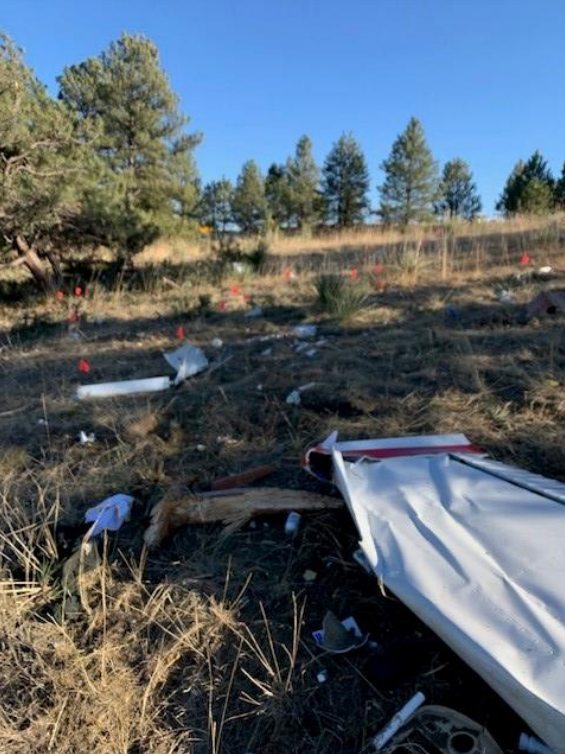
ASN Wikibase Occurrence # 244535
This information is added by users of ASN. Neither ASN nor the Flight Safety Foundation are responsible for the completeness or correctness of this information.
If you feel this information is incomplete or incorrect, you can submit corrected information.
| Date: | Friday 30 October 2020 |
| Time: | 19:05 |
| Type: |  Cessna 172M Skyhawk |
| Owner/operator: | Private |
| Registration: | N124TW |
| MSN: | 17265696 |
| Year of manufacture: | 1975 |
| Engine model: | Lycoming O-320 |
| Fatalities: | Fatalities: 1 / Occupants: 1 |
| Aircraft damage: | Destroyed |
| Category: | Accident |
| Location: | near Billings Logan International Airport (BIL/KBIL), MT -
 United States of America United States of America
|
| Phase: | Approach |
| Nature: | Private |
| Departure airport: | Sheridan Airport, WY (SHR/KSHR) |
| Billings-Logan International Airport, MT (BIL/KBIL) | |
| Investigating agency: | NTSB |
| Confidence Rating: |
On October 30, 2020, about 1905 mountain daylight time (MDT), a Cessna 172M airplane, N124TW, was substantially damaged when it was involved in an accident near Billings, Montana. The pilot was fatally injured. The airplane was operated as a Title 14 Code of Federal Regulations Part 91 cross-country flight.
The pilot departed on the last leg of a multi-leg cross-country flight during dark night conditions. Air traffic control communications indicate he reported encountering wind shear, turbulence and difficulties continuing the flight at night with strong headwinds. The pilot also reported that he was not able to climb to an altitude to safely navigate mountainous terrain and needed to divert to another airport. During the approach the pilot was unable to identify the runway from other flashing lights that were likely part of a planned memorial procession and light display that was lined up near the airport. The controller gave the pilot a position report and the pilot reported that he thought he had the airport in sight. The controller advised the pilot to maneuver as necessary and to maintain an altitude of 4,500 ft mean sea level (msl) or higher.
After some maneuvering the pilot reported that he did not have the runway in sight. The controller then requested that he pass over the top of the airport and the pilot replied he had the runway in sight. During the approach the pilot impacted trees and terrain about 3/4 mile from the runway.
The accident site examination revealed that the airplane impacted a large tree and then terrain which was located along the runway centerline. Branches surrounding the large tree revealed propeller strike marks, suggesting an undetermined amount of engine power during the accident sequence. The postaccident examination of the airframe and engine revealed no evidence of mechanical malfunctions or failures that would have precluded normal operation.
An airplane performance study revealed that airspeed and airplane attitude information estimated from automatic dependent surveillance-broadcast equipment and winds aloft data indicate that the airplane impacted a tree and terrain while in a controlled descent and that an aerodynamic stall was not likely a factor.
The airplane was operating at altitudes between 7,000 and 11,000 ft msl for most of the 2 hour 6-minute accident flight, and it was night for the last 30 minutes with the airplane largely operating between 4,000 and 9,000 ft msl.
The pilot’s severe cardiovascular disease placed him at increased risk of an acute cardiac event such as ischemia or arrhythmia that can cause sudden incapacitating symptoms and leave no evidence at autopsy. Whether the pilot was impaired or incapacitated by his cardiac disease or some other medical condition at the time of the accident could not be determined by this investigation.
However, whether the cause of the airplane’s behavior was due to an incapacitating medical condition, distraction, wind shear, or some other factor is not known from the available operational information.
Probable Cause: The pilot’s failure to maintain the proper descent glide path while on final approach for reasons that could not be determined from available evidence.
Accident investigation:
 |
|
Sources:
https://www.newsbreak.com/montana/billings/news/2093339423240/small-plane-crashes-north-of-billings-airport-friday-night
https://www.ktvq.com/news/local-news/small-plane-crashes-near-billings-airport
NTSB
https://flightaware.com/live/flight/N124TW/history/20201030/2321Z
http://archive-server.liveatc.net/kbil/KBIL-Twr-Oct-31-2020-0100Z.mp3 (Starts right at 0100Z)
Location
Images:


Photos: NTSB
Revision history:
| Date/time | Contributor | Updates |
|---|---|---|
| 31-Oct-2020 07:53 | gerard57 | Added |
| 31-Oct-2020 08:07 | gerard57 | Updated [Total fatalities, Total occupants, Other fatalities, Source, Damage, Narrative] |
| 31-Oct-2020 08:19 | gerard57 | Updated [Time, Source] |
| 31-Oct-2020 09:09 | RobertMB | Updated [Time, Aircraft type, Registration, Cn, Location, Phase, Destination airport, Source, Narrative] |
| 31-Oct-2020 17:04 | Anon. | Updated [Registration, Departure airport, Source, Narrative] |
| 31-Oct-2020 21:14 | Captain Adam | Updated [Narrative] |
| 08-Nov-2020 08:03 | Anon. | Updated [Narrative] |
| 10-Jul-2021 09:26 | aaronwk | Updated [Time, Departure airport, Source, Narrative, Category] |
Corrections or additions? ... Edit this accident description
The Aviation Safety Network is an exclusive service provided by:


 ©2024 Flight Safety Foundation
©2024 Flight Safety Foundation